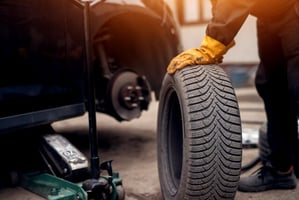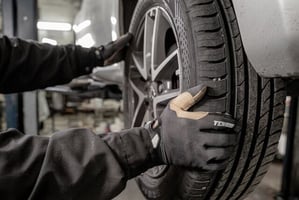Towing a trailer can sometimes feel like a balancing act.
Have you ever noticed how your vehicle shifts and sways when you brake, accelerate, or turn?
That’s weight transfer at work and managing it right is key to safer, smoother towing. Engineered weight transfer control systems, like the ProPride 3P® hitch with its patented Pivot Point Projection™, help shift your trailer’s weight smoothly onto your truck. The result? Reduced sway, better stability, and more confidence behind the wheel.
Unlike older friction-based hitches that fight sway after it starts, weight transfer control prevents it by spreading forces evenly across your vehicle’s frame and suspension. Think of it as an intelligent balance system that works mechanically to keep your rig steady no matter the road conditions. This technology not only improves your towing safety but also protects your vehicle and trailer from unnecessary wear and tear.
By understanding how engineered weight transfer control works, you’ll appreciate how modern hitches transform the towing experience. From precise mechanical parts to smart vehicle dynamics, this system is designed to keep every drive smooth and every mile safer.
In this blog, we will cover:
- What engineered weight transfer control means and why it matters for towing stability
- The key components that manage weight distribution and reduce trailer sway
- How modern tech and vehicle systems work together for a safer towing experience
Let’s dive in!
Understanding Engineered Weight Transfer Control
Engineered weight transfer control helps you manage how the weight between your towing vehicle and trailer shifts while driving. It uses precise mechanical parts to improve stability, reduce sway, and keep your setup safer on the road.
Principles of Weight Transfer
Weight transfer control moves trailer weight to the vehicle's strongest points. This reduces the chance of trailer sway by keeping the load balanced and steady.
When you brake, accelerate, or turn, weight shifts between the axle and hitch. Engineered systems spread this force evenly across the towing vehicle’s frame and suspension to prevent sudden shifts, minimizing jerkiness and loss of control.
Engineered control uses mechanical leverage and pivot points instead of friction-based hitches. This creates a smoother ride and better towing safety without extra friction to wear down parts.
Key Components Involved
The hitch head, frame bracket, control links, and spring bars are essential. These work together to control how force moves from the trailer to your vehicle.
- The hitch head connects to your trailer and moves with it using a patented design that creates a virtual pivot point.
- The frame bracket mounts securely to your vehicle's frame.
- Spring bars and control links push and pull to balance weight and reduce sway.
For example, the ProPride 3P® Hitch uses a one-piece yoke instead of separate strut bars. This improves strength and reduces zero-point connections that can fail, giving you more confidence while towing.
Role in Vehicle Dynamics
Weight transfer affects your vehicle's traction, steering, and braking. When balanced correctly, your truck handles better and feels more stable.
Good weight transfer reduces sway, which can cause dangerous fishtailing or loss of control. It also helps maintain even tire contact on the road, which improves braking distance and steering responsiveness.
This control mimics some of the benefits of a fifth-wheel hitch without special beds or mounts, making it easier to get a safer towing experience with a bumper pull setup.
Applications of Engineered Weight Transfer Control
Engineered weight transfer control improves stability by managing forces between your vehicle and trailer or load. This control helps reduce sway, improve handling, and optimize weight distribution. It is essential for towing safety, performance, and efficiency in various vehicles and conditions.
Automotive Industry Use Cases
In the automotive world, weight transfer control makes towing safer and smoother.
When you tow a trailer, weight shifts can cause the trailer to sway, but engineered systems like the ProPride 3P® hitch use Pivot Point Projection™ to stabilize your load.
This control helps balance the forces on the hitch and your vehicle's frame, reducing side-to-side motion. It also aids in even weight distribution across axles, helping you maintain control, especially during sharp turns or sudden stops. You get better traction and less stress on your suspension.
This control system supports a confident drive and improves overall safety for passenger cars towing campers or boats. Proper weight transfer means fewer jerks and a more comfortable ride for you and your passengers.
Motorsport Performance Enhancements
In motorsports, engineered weight transfer control is critical for cornering speed, stability, and vehicle response. Racers rely on precise handling, where shifting weight significantly affects tire grip and vehicle balance.
By actively managing these forces, systems inspired by weight transfer control principles help keep the car stable at high speeds and quick maneuvers. This control improves traction when accelerating, braking, or turning by optimizing how weight moves across the chassis.
You benefit from quicker lap times and better vehicle predictability. Motorsport teams often tune these systems to fit their vehicles' needs, ensuring maximum performance while keeping safety intact during aggressive driving.
Commercial Vehicle Optimization
Weight transfer control reduces wear and increases safety for commercial trucks and trailers over long hauls. A stable connection between tractor and trailer means less sway and fewer highway accidents.
Engineered weight transfer systems distribute load forces to improve tire contact and reduce excessive frame stress. This lowers maintenance costs and reduces downtime for your vehicle fleet.
An advanced design, like the patented technology in the ProPride 3P® hitch, also simplifies installation and provides durable performance without extra parts like strut bars.
This technology ensures a smooth, controlled ride even with heavy or uneven loads, which is crucial for protecting cargo and maintaining timely deliveries.
Advancements and Technology Trends
Recent developments have improved how weight transfer control systems manage trailer sway. These innovations help you tow with better stability and safety by using smarter suspension, better electronic control, and advanced sensors.
Adaptive Suspension Systems
Adaptive suspension systems adjust in real time based on road conditions and vehicle load. They use sensors to detect changes in weight distribution and adjust the stiffness of the suspension. This helps reduce sway and improves handling during sharp turns or sudden stops.
These systems automatically stiffen or soften the suspension on each wheel. You get more control without manual adjustments. This is key for towing heavy loads where balance shifts constantly.
Adaptive technology pairs well with ProPride’s engineered weight transfer design, adding another layer of stability for smooth towing. It reduces the chances of sway by balancing forces through the suspension, keeping trailers steady.
Integration with Electronic Stability Control
Electronic Stability Control (ESC) systems help prevent trailer sway by applying brakes on specific wheels and reducing engine power when needed. Advanced weight transfer control now links directly with ESC, allowing quicker and more precise responses.
This integration means your vehicle can detect trailer sway earlier and activate corrections faster. The coordinated brake and throttle adjustments help you stay in control, especially in windy conditions or on uneven roads.
When combined with the ProPride 3P® Hitch, ESC works more effectively because the hitch limits the initial sway. This partnership between hardware and software provides a safer towing experience than traditional anti-sway hitches.
Software and Sensor Innovations
Modern weight transfer control uses powerful software algorithms and high-precision sensors. These sensors monitor yaw, pitch, roll, and lateral movement to understand exactly how the trailer and tow vehicle interact.
Software processes this data instantly to make adjustments through either suspension or ESC systems. This real-time analysis prevents sway before it becomes noticeable.
You benefit from improved towing safety because the system continuously learns and adapts to your driving habits and road conditions. ProPride uses this data-driven approach to enhance its patented Pivot Point Projection™, making its trailer sway control more responsive and reliable than older models.
Frequently Asked Questions
Towing safely is about more than just hitching your trailer—it’s understanding how weight transfer and sway control work in real-world conditions. Whether you’re new to towing or looking to upgrade your setup, these questions cover what many drivers want to know but aren’t always sure where to ask.
How does engineered weight transfer improve towing stability compared to traditional systems?
Engineered weight transfer evenly distributes trailer forces across your vehicle’s frame and suspension, preventing sudden shifts that cause sway. Unlike friction-based hitches, it eliminates sway before it starts, resulting in smoother, safer rides with less wear on your truck and trailer.
Can weight transfer control reduce driver fatigue on long trips?
Yes! By minimizing sway and sudden trailer movements, weight transfer control reduces the constant steering corrections drivers make. This leads to a calmer, less stressful driving experience, helping you stay focused and comfortable even during long hauls.
What maintenance should I perform on my weight transfer hitch system?
Regularly inspect the hitch for loose bolts, wear on control links, and lubrication needs on pivot points. Cleaning off dirt and rust also prolongs hitch life. Proper upkeep ensures your weight transfer system functions smoothly and maintains towing safety.
Is engineered weight transfer control compatible with all tow vehicles and trailers?
Most advanced systems, like the ProPride 3P® hitch, offer adjustable components to fit various tow vehicles and trailer types. Always verify compatibility with your vehicle’s frame, hitch receiver size, and trailer weight for the best performance and safety.
How does weight transfer impact tire wear and braking efficiency?
Proper weight transfer balances load across tires, preventing uneven wear and improving traction. This balanced load also supports consistent braking performance, reducing stopping distances and enhancing overall vehicle control while towing.
Can weight transfer technology be combined with electronic stability control (ESC) systems?
Yes, modern vehicles integrate ESC with weight transfer control for optimal sway prevention. ESC applies targeted braking and engine adjustments, while engineered weight transfer manages physical load distribution, together providing a comprehensive safety net for towing.


